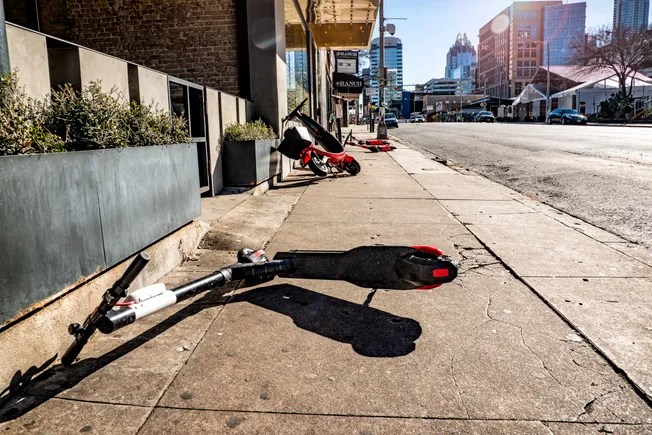Tackling Micromobility Clutter: Pensacola’s Innovative Approach to E-Scooter Parking
In recent years, the rise of shared e-scooter programs has transformed urban transportation, offering a convenient and eco-friendly alternative for short trips. However, as cities embrace this new mode of transport, they face significant challenges related to the improper parking of dockless vehicles. Pensacola, Florida, has emerged as a case study in effectively managing this issue, implementing a comprehensive strategy that has significantly reduced clutter and improved the pedestrian experience.
The Challenge of Improper Parking
Before the city made its shared e-scooter program permanent in 2022, improperly parked scooters were a major headache for Pensacola residents. These dockless vehicles often blocked sidewalks, storefronts, and pedestrian ramps, making navigation difficult, particularly for individuals with disabilities. Complaints about these issues flooded the city’s 311 system, prompting officials to take action.
Designated Parking Corrals: A Solution in Action
In response to the growing problem, Pensacola introduced designated "corrals" for e-scooter parking. These specific areas are strategically located throughout the downtown region, allowing riders to park their scooters in a manner that minimizes obstruction. According to Caitlin Cerame, the city’s transportation planner, this initiative has proven effective. Since the implementation of the parking requirements, complaints about improperly parked scooters have dropped significantly, indicating a positive shift in rider behavior.
Learning from Other Cities
Pensacola is not alone in its struggle with micromobility clutter. Cities across the United States, including Atlanta and Washington, D.C., have faced similar challenges as shared e-scooters and bikes gain popularity. Many local governments have adopted regulations to manage parking, such as limiting where and when riders can leave their vehicles. Some cities, like Chicago and Portland, have implemented "lock-to" requirements, mandating that riders secure their scooters to fixed objects like bike racks or signposts.
The Importance of Accessibility
Research indicates that the likelihood of proper parking increases when riders can find designated parking within a one-minute walk of their destination. A report from the Urbanism Next Center at the University of Oregon highlights that while increasing the number of parking corrals can improve compliance, there is a threshold beyond which additional corrals yield diminishing returns. Specifically, cities should aim for a density of 50 to 80 corrals per square mile to maximize effectiveness.
Moreover, it is crucial for city planners to distribute parking corrals evenly across service areas to avoid creating "parking deserts." Areas with high pedestrian traffic, such as mixed-use and tourist zones, should feature higher-capacity corrals to accommodate demand during peak times.
Pensacola’s Comprehensive Strategy
What sets Pensacola apart is its multifaceted approach to managing e-scooter parking. The city has not only established designated parking corrals but has also implemented a ban on sidewalk parking in high-traffic areas. This combination of infrastructure and policy has made it easier for riders to park responsibly while ensuring pedestrian pathways remain clear.
Additionally, Pensacola has introduced a technological component to its parking strategy. Riders are required to take a photo of their parked scooter and submit it through the Veo Mobility app, which operates the city’s dockless scooters. This accountability measure, coupled with fines of up to $150 for improper parking, encourages compliance among users.
Collaborative Enforcement and Responsiveness
Veo Mobility has also committed to responding to parking complaints within one hour, creating a system of accountability that incentivizes the company to monitor its users actively. This collaborative approach between the city and the micromobility operator has led to a significant reduction in parking-related issues. Cerame notes that complaints have decreased to the point where the city receives only one every four months, a remarkable improvement from the pre-implementation era.
The Future of Micromobility Management
As cities continue to grapple with the challenges posed by shared micromobility services, Pensacola’s experience offers valuable insights. The combination of designated parking, technological solutions, and collaborative enforcement can create a more organized and user-friendly environment for both riders and pedestrians.
Moreover, the integration of mobility hubs—locations that provide access to various transportation modes—could further enhance the effectiveness of micromobility services. By offering ample parking for bicycles, scooters, and other small vehicles in one place, cities can create a seamless transportation experience that benefits everyone.
Conclusion
The rise of shared e-scooters presents both opportunities and challenges for urban transportation. Pensacola’s innovative approach to managing e-scooter parking serves as a model for other cities facing similar issues. By combining infrastructure, technology, and policy, Pensacola has successfully reduced micromobility clutter, improved pedestrian safety, and created a more enjoyable urban environment. As cities continue to evolve in their transportation strategies, the lessons learned from Pensacola will undoubtedly play a crucial role in shaping the future of micromobility management.
